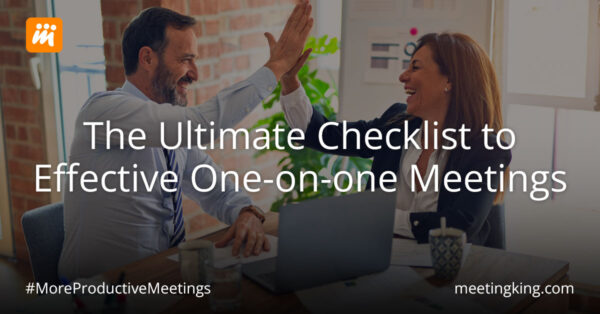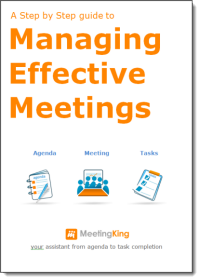
One-on-one meetings are an integral part of any successful manager-employee relationship. Effective one-on-one meetings help build trust, increase productivity, and align personal and organizational goals.
In this blog post, we will share with you a comprehensive checklist to ensure that your one-on-ones are productive, efficient, and meaningful. Let’s dive in.
1. Review Notes from the Past Meeting
The first step to effective one-on-one meetings is to review notes from the previous meeting. This helps both the manager and the employee to keep track of what was discussed, what was accomplished, and what still needs to be addressed. Furthermore, by reviewing notes, you can avoid repeating the same topics, saving you time as a result.
2. Set Agenda in Advance
Another key step to effective one-on-one meetings is to set an agenda in advance. This allows both parties to prepare and collaborate on the topics to be discussed. A collaborative agenda ensures that the meeting is focused and addresses the most important issues.
3. Prepare a Few Backup Questions
Sometimes, one-on-one meetings can hit a roadblock, and there may be nothing left to discuss. This can be a good thing as it indicates that the meeting has covered everything that needed to be addressed. However, if the employee is feeling intimidated or uncomfortable, having backup questions relevant to their career growth and development can help put them at ease and keep the conversation flowing.
By preparing a few backup questions and actively listening to employees’ thoughts and aspirations, managers can not only keep the conversation flowing but also create a safe space for them to share their concerns.
4. Determine Goals and Expectations
Before starting your next one-on-one. it is a good idea to define its purpose and expectations. For example, a great goal could be identifying and eliminating obstacles. An example of expectations could be coming prepared and never canceling the meeting.
5. Set a Regular Schedule
Regularly scheduled one-on-one meetings are important for maintaining consistency, but the frequency can vary based on the individual’s needs. More frequent meetings may be necessary for employees who require more guidance or are working on complex projects. On the other hand, if the employee is performing well and needs less supervision, meetings can be less frequent.
Sometimes, you may need to hold one-on-one meetings outside of the regular schedule for urgent matters. For instance, if an employee’s behavior or actions are unprofessional and may harm the company’s reputation.
6. Keep Everything in One Place
It’s essential to keep track of all the notes, action items, and follow-ups. This ensures that nothing falls through the cracks and helps both the manager and the employee to stay on top of their tasks.
Moreover, using a tool like MeetingKing to capture this information helps you keep everything in one place and track and analyze progress. In addition, you can easily look up past discussions, making it simple to assess achievements and set new goals for future meetings.
7. Create a Safe Space
These meetings should be a safe space for employees to share their concerns, challenges, and aspirations. Managers should create an environment where employees feel comfortable sharing their thoughts without the fear of judgment or retaliation.
8. Listen Actively
Effective one-on-one meetings require active listening. As a manager, it’s important to listen to what the employee is saying, understand their perspective, and acknowledge their ideas. What’s more, active listening creates a safe space for employee to share their thoughts and concerns, ultimately building trust and fostering a positive relationship.
9. Discuss Challenges
One-on-one meetings are an excellent opportunity to discuss challenges that are affecting their productivity. These could be work-related personal. Managers can support and guide employees in overcoming challenges by promoting open discussions about them.
10. Give Feedback
Feedback is a critical component of any strong manager-employee relationship. In fact, providing constructive feedback to employees is essential for helping them improve their performance and achieve their goals.
To make feedback effective, it should be specific, actionable, and focused on the employee’s growth and development. By creating an open and safe environment for feedback, managers can help build trust, foster growth and development, and improve the overall performance of their team.
11. Receive Feedback
In addition to giving feedback, managers should also accept feedback from their employees to gain valuable insights into their own performance and leadership style. By accepting feedback constructively and non-defensively, managers can identify areas for improvement and develop stronger relationships with their employees. This can ultimately improve their leadership skills and help their team achieve their goals.
12. Acknowledge Wins
It’s essential to acknowledge and celebrate wins and accomplishments during one-on-one meetings. By recognizing and appreciating the employee’s hard work and achievements, managers can boost their work satisfaction and productivity.
13. Take Notes
Taking notes during one-on-ones is crucial to ensure that important information is captured and followed up on. As a manager, taking notes helps you to remember action items, commitments, and progress made by the employee.
You can take notes manually, on a piece of paper, or electronically, by using comprehensive meeting management software like MeetingKing. MeetingKing not only allows you to take electronic notes but also to centralize them in one accessible location. This way, all the crucial meeting details, and records are stored alongside other relevant information, providing an overview of discussions and outcomes.
14. Follow up
Following up after each one-on-one meeting ensures that action items and commitments are followed through. As a manager, it’s important to set deadlines and expectations for follow-up items and to hold yourself accountable for them. Follow-up items should be prioritized based on their urgency and importance, and progress should be communicated regularly.
In Summary
Effective one-on-one meetings are essential for building strong relationships between managers and employees, fostering open communication, and achieving common goals. Implementing the strategies outlined in this blog post enables managers to build a culture of trust, accountability, and transparency. Consequently, this cultivates increased engagement, motivation, and retention of top talent.
One-on-one meetings are not just a box to check off, but a valuable opportunity to invest in your employees’ growth, development, and success.
__
The image above by krakenimages on Unsplash


